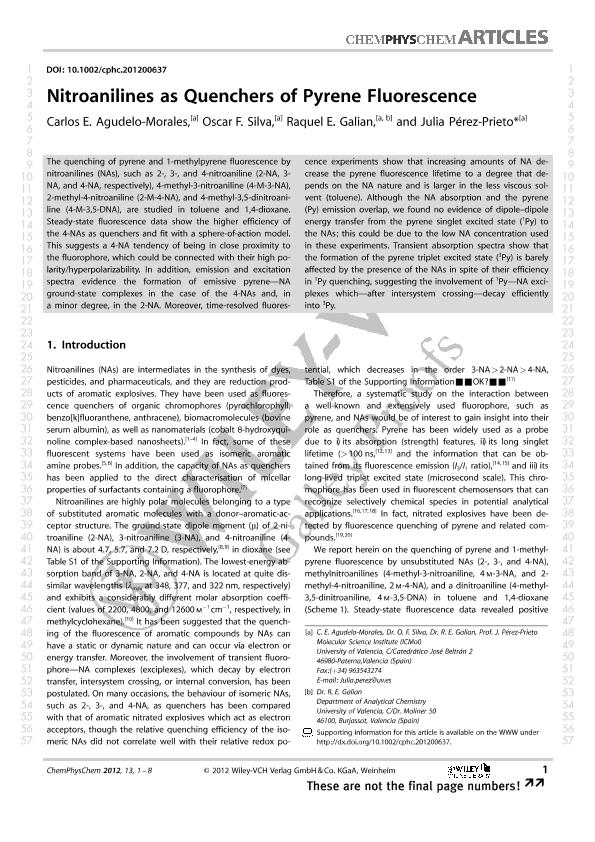Artículo
Nitroanilines as Quenchers of Pyrene Fluorescence
Fecha de publicación:
12/2012
Editorial:
Wiley VCH Verlag
Revista:
Chemphyschem
ISSN:
1439-4235
Idioma:
Inglés
Tipo de recurso:
Artículo publicado
Clasificación temática:
Resumen
The quenching of pyrene and 1‐methylpyrene fluorescence by nitroanilines (NAs), such as 2‐, 3‐, and 4‐nitroaniline (2‐NA, 3‐NA, and 4‐NA, respectively), 4‐methyl‐3‐nitroaniline (4‐M‐3‐NA), 2‐methyl‐4‐nitroaniline (2‐M‐4‐NA), and 4‐methyl‐3,5‐dinitroaniline (4‐M‐3,5‐DNA), are studied in toluene and 1,4‐dioxane. Steady‐state fluorescence data show the higher efficiency of the 4‐NAs as quenchers and fit with a sphere‐of‐action model. This suggests a 4‐NA tendency of being in close proximity to the fluorophore, which could be connected with their high polarity/hyperpolarizability. In addition, emission and excitation spectra evidence the formation of emissive pyrene—NA ground‐state complexes in the case of the 4‐NAs and, in a minor degree, in the 2‐NA. Moreover, time‐resolved fluorescence experiments show that increasing amounts of NA decrease the pyrene fluorescence lifetime to a degree that depends on the NA nature and is larger in the less viscous solvent (toluene). Although the NA absorption and the pyrene (Py) emission overlap, we found no evidence of dipole–dipole energy transfer from the pyrene singlet excited state (1Py) to the NAs; this could be due to the low NA concentration used in these experiments. Transient absorption spectra show that the formation of the pyrene triplet excited state (3Py) is barely affected by the presence of the NAs in spite of their efficiency in 1Py quenching, suggesting the involvement of 1Py—NA exciplexes which—after intersystem crossing—decay efficiently into 3Py.
Palabras clave:
Pireno
,
Fotoquimica
,
Anilinas
,
Desactivacion
Archivos asociados
Licencia
Identificadores
Colecciones
Articulos(INFIQC)
Articulos de INST.DE INVESTIGACIONES EN FISICO- QUIMICA DE CORDOBA
Articulos de INST.DE INVESTIGACIONES EN FISICO- QUIMICA DE CORDOBA
Citación
Agudelo Morales, Carlos E.; Silva, Oscar Fernando; Galian, Raquel Eugenia; Pérez Prieto, Julia; Nitroanilines as Quenchers of Pyrene Fluorescence; Wiley VCH Verlag; Chemphyschem; 13; 18; 12-2012; 4195-4201
Compartir
Altmétricas




